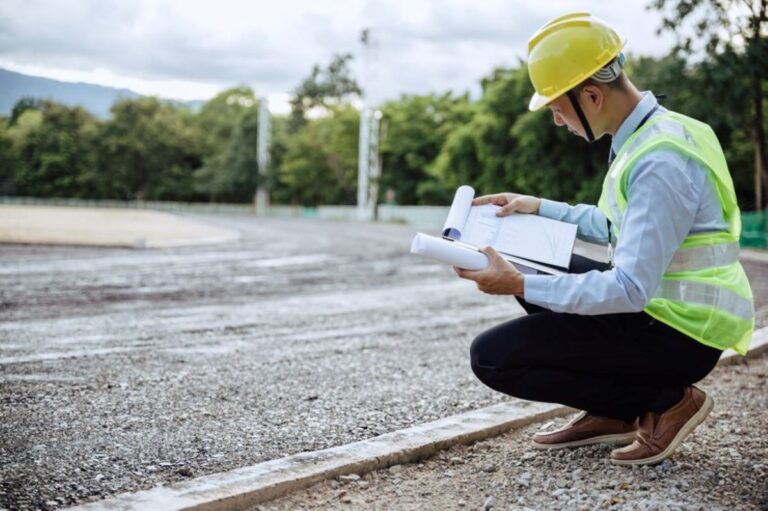Land Surveying: What Every Property Owner Should Know
Land surveying is a crucial professional service that determines the exact locations of points and boundaries on, above, or below the Earth’s surface. This specialised field combines elements of mathematics, engineering, and law to create detailed documentation of property boundaries and terrain characteristics.
Property owners rely on land surveying to establish clear property lines, verify land measurements, and obtain accurate documentation for legal purposes. A professional survey provides essential data for:
- Property boundary determination
- Construction planning and development
- Legal dispute resolution
- Compliance with local regulations
- Property value assessment
The surveying process supports multiple aspects of property management through precise measurements and detailed documentation. These measurements form the foundation for construction projects, property transactions, and legal proceedings. Professional surveyors utilise advanced technology and established methodologies to create legally binding documents that protect property rights and ensure regulatory compliance.
This comprehensive guide explores the essential aspects of land surveying that every property owner should understand to make informed decisions about their real estate investments.
Understanding Land Surveying Basics
Land surveying combines precise measurements, technical expertise, and legal documentation to determine property boundaries and land characteristics. A comprehensive land survey consists of three essential components:
- Field Measurements: Physical data collection using specialised equipment to measure distances, angles, and elevations
- Legal Descriptions: Written documentation detailing property boundaries, easements, and rights-of-way
- Survey Diagrams: Visual representations showing property lines, structures, and topographical features
Different property needs require specific types of surveys:
Boundary Surveys
- Establishes exact property lines
- Identifies encroachments
- Locates corner markers
ALTA Surveys
- Meets American Land Title Association standards
- Details improvements, easements, and access rights
- Required for commercial property transactions
Topographic Surveys
- Maps natural and artificial features
- Shows elevation changes
- Identifies drainage patterns
Additional Survey Types
- Site Plans: Details proposed improvements
- Construction Layouts: Guides building placement
- Subdivision Surveys: Divides land into smaller parcels
- Elevation Certificates: Documents flood risk areas
Each survey type serves distinct purposes in property development, legal compliance, and land management. Professional surveyors select appropriate survey methods based on specific project requirements and local regulations.
Why Land Surveying Matters to Property Owners
Land surveying is a crucial tool for property owners, providing essential protection and guidance in various aspects of property ownership and development.
1. Resolving Boundary Disputes
Professional land surveys offer legally binding documentation that clearly defines property boundaries. This documentation is invaluable when dealing with:
- Neighbour disputes over fence placements
- Conflicts regarding tree removal
- Issues related to structural encroachment
- Disagreements about driveways or access ways
2. Ensuring Construction Planning Excellence
Accurate surveys are the foundation for successful construction projects by:
- Identifying suitable locations for buildings
- Determining the best placement for foundations
- Revealing challenges posed by the terrain
- Mapping out existing utilities and infrastructure
3. Ensuring Zoning Compliance
Land surveys assist property owners in navigating complex local regulations, such as those outlined in the Cumberland County Zoning Ordinance, by:
- Verifying setback requirements
- Confirming restrictions on building height
- Assessing limitations on lot coverage
- Providing documentation for permit applications
4. Assessing Property Value
Detailed surveys contribute to accurate property valuations by documenting:
- Exact measurements of the land
- Topographical features such as hills or valleys
- Natural resources present on the property
- Potential for development
A professional land survey serves as a safeguard against expensive legal disputes, construction mistakes, and violations of compliance. The comprehensive information obtained through surveying empowers property owners to make informed decisions about how to use their land while also protecting their investment.
Essential Land Surveying Terms Every Property Owner Should Know
Property owners must familiarise themselves with crucial land surveying terminology to navigate property-related decisions effectively. Here are the fundamental terms that shape property boundaries and legal descriptions:
- Metes and Bounds: A legal property description using physical features and measurements to define boundaries
- Monuments: Physical markers like iron pins, concrete posts, or natural landmarks that define property corners
- Easement: A legal right for others to use a portion of property for specific purposes
- Setback: Required minimum distance between buildings and property lines
- Flood Zone: Designated areas with specific flood risks that affect property use and insurance

Additional Key Terms
- Replat: A legal process to modify existing property boundaries or easements within a platted subdivision
- Encroachment: When structures or improvements extend beyond property boundaries onto neighbouring land
- Right-of-Way: A type of easement allowing passage through private property for roads, utilities, or public access
- Benchmark: A fixed reference point used to determine elevation levels and heights
- Contour Lines: Map elements showing points of equal elevation to represent terrain shape and slopes
These terms form the foundation of property documentation and legal descriptions. Understanding their meanings helps property owners make informed decisions about boundary adjustments, construction projects, and property improvements.
Markers and Tools Used in Surveying
Professional land surveyors use specific tools and markers to establish precise property boundaries. Corner pins or stakes serve as permanent markers at property corners, typically made of metal or concrete for durability. These markers remain in place indefinitely to maintain accurate boundary records.
Flagging tape plays a vital role in temporary visual marking. Surveyors attach brightly coloured tape to trees, stakes, or other fixed objects to indicate:
- Survey control points
- Property lines
- Utility easements
- Construction boundaries
Pin finder devices help locate buried survey markers through electromagnetic detection. These specialised tools prove invaluable when markers become covered by soil, vegetation, or construction materials.
Adjoiners represent neighbouring properties that share common boundaries. Accurate identification of adjoiners ensures proper alignment of property lines and helps prevent boundary disputes. Professional surveyors document adjoiner information in their surveys to establish clear relationships between adjacent properties.
Modern surveying equipment includes:
- Digital theodolites
- GPS receivers
- Electronic distance measurement devices
- 3D laser scanners
- Data collectors
These precision instruments enable surveyors to gather accurate measurements and create detailed property documentation.
The Surveying Process Explained
Professional land surveying follows a systematic process that combines traditional field methods with cutting-edge technology. The process begins with thorough research of existing property records, historical surveys, and legal documents to establish baseline information.
Field Survey Phase:
- Initial site reconnaissance and planning
- Setting up control points using GPS receivers
- Taking precise measurements with electronic total stations
- Collecting topographic data through 3D laser scanning
- Documenting existing structures and features
Modern surveying technology has revolutionised the field with remarkable precision:
- Real-time kinematic (RTK) GPS systems accurate to within centimetres
- Robotic total stations for automated measurements
- LiDAR scanners capturing millions of data points
- Drone photogrammetry for aerial mapping
- Digital levels for precise elevation measurements
The collected data undergoes rigorous processing and analysis in specialised software. Surveyors create detailed Computer-Aided Design (CAD) drawings, incorporating:
- Property boundaries
- Elevation contours
- Structure locations
- Utility positions
- Legal descriptions
The final documentation package includes certified survey plans, technical reports, and legal descriptions. These documents serve as legally binding records that meet strict professional standards and local regulations. Professional surveyors maintain detailed records of all measurements, calculations, and field notes to support their findings.
Advanced data management systems ensure secure storage and easy retrieval of survey information for future reference or updates. This comprehensive documentation becomes an essential resource for property owners, developers, and legal professionals.
See Also : Boundary Survey Cost Sydney: What You Need to Budget For
Choosing a Professional Land Surveyor
Selecting a qualified land surveyor requires careful consideration of credentials, experience, and service quality. Professional surveyors must hold specific qualifications, including:
- Bachelor’s degree in surveying or related field
- State registration and licensing
- Advanced mathematical proficiency
- Knowledge of property law and regulations
- Expertise in surveying equipment and software
Registered surveyors provide comprehensive services across diverse sectors:
- Property boundary determinations
- Construction site layouts
- Infrastructure project planning
- Topographic mapping
- Subdivision planning
- Legal documentation preparation
A reputable surveying firm demonstrates these essential qualities:
- Professional Insurance Coverage: Protection against errors and liability
- Modern Equipment: Latest technology for accurate measurements
- Documented Experience: Portfolio of successful projects
- Client References: Positive testimonials from previous customers
- Clear Communication: Detailed explanations of processes and findings
- Competitive Pricing: Transparent fee structures with no hidden costs
The selection of a surveying firm impacts project success rates and legal compliance. Local firms familiar with regional regulations and terrain characteristics bring additional value through their specialised knowledge. Professional surveyors who maintain active memberships in industry associations demonstrate commitment to current best practices and professional development.

Conclusion
Professional land surveying is a crucial investment for protecting property rights and ensuring compliance with regulations. Accurate surveys prevent boundary disputes, support informed decision-making, and safeguard property investments from costly mistakes.
A qualified land surveyor brings essential expertise to:
- Resolve boundary uncertainties
- Ensure construction project compliance
- Protect against encroachment issues
- Document property features accurately
- Maintain legal compliance
The cost of skipping proper surveys can result in significant financial losses, legal complications, and property disputes. Working with registered surveyors who possess the right qualifications, tools, and experience delivers peace of mind and precise documentation for property decisions.
The value of professional land surveying goes beyond just measurements – it provides the foundation for sound property ownership and development. Engaging qualified surveyors helps property owners make informed decisions while protecting their investments through accurate, legally-binding documentation.



